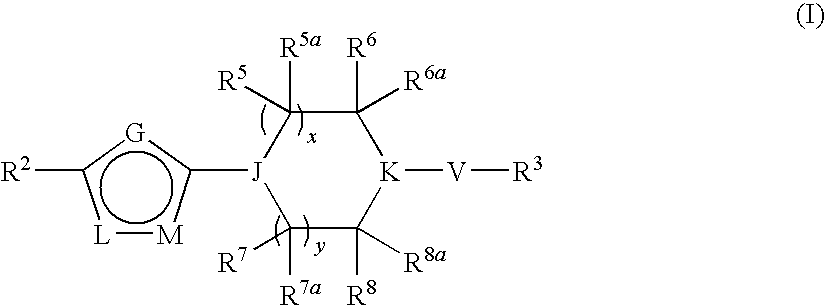Heterocyclic derivatives and their use as stearoyl-CoA desaturase inhibitors
a technology of desaturase inhibitors and heterocyclic derivatives, which is applied in the direction of drug compositions, metabolic disorders, cardiovascular disorders, etc., can solve the problems that known modulators of delta-9 desaturase activity are not useful in treating diseases and disorders linked to scd1 biological activity, and achieve effective modulation of triglyceride level, reduce lipid levels, and improve the effect of lipid level
- Summary
- Abstract
- Description
- Claims
- Application Information
AI Technical Summary
Benefits of technology
Problems solved by technology
Method used
Image
Examples
preparation 1
Synthesis OF [4-(6-Aminopyridazin-3-yl)piperazin-1-YL]-(2-trifluoromethylphenyl)methanone
[0268]A. To a stirred solution of 1-Boc-piperazine (1.96 g, 10.5 mmol) in dichloromethane (50 mL) was added 2-trifluoromethylbenzoyl chloride (2.09 g, 10.0 mmol) as a dichloromethane solution in the presence of triethylamine (3 mL) at 0° C. The resulting mixture was stirred at ambient temperature for 18 hours and then quenched with water (25 mL). The organic phase was washed with water, brine, dried over MgSO4 and then concentrated in vacuo to afford the desired product as a pall yellow solid used for next step reaction without further purification.
[0269]B. A solution of the compound obtained above (10 mmol) in 50 mL of a 1:4 mixture of trifluoroacetic acid and dichloromethane was stirred at ambient temperature for 5 h. After concentration in vacuo the residue was dissolved in dichloromethane (100 mL) and washed sequentially with 1 N NaOH (10 mL), water, brine, and then dried over MgSO4, filtere...
preparation 2
Synthesis of N-Hydroxy-4-Methylpentanamidine
[0271]A mixture of isocapronitrile (1.00 g, 10.30 mmol), hydroxylamine hydrochloride (0.786 g, 11.32 mmol), and sodium hydroxide (0.453 g, 11.32 mmol) in EtOH (21 mL) and water (5 mL) was stirred at room temperature for 48 hours. The reaction mixture was concentrated in vacuo to yield a white solid which was re-dissolved in dichloromethane (100 mL). The insoluble salt was removed by filtration. The organic layer was concentrated in vacuo to dryness. The title compound was obtained as a white solid in 55% yield (0.730 g). 1H NMR (300 MHz, CDCl3) δ 6.6 (br., s, 1H), 4.5 (br., s, 2H), 2.2 (m, 2H), 1.50 (m, 1H), 1.4 (m, 2H), 0.85 (m, 6H).
preparation 3
Synthesis OF 6-[4-(2-Trifluoromethylbenzoyl)piperazin-1-yl]pyridazine-3-carboxylic Acid
[0272]A. To a methanol solution of 6-oxo-1,6-dihydropyridazine-3-carboxylic acid monohydrate (5.00 g, 31.6 mmol) was added thionyl chloride (0.36 mL, 0.59 g, 4.94 mmol). The reaction mixture was heated to reflux at 80° C. for 16 h. The product crystallized after the reaction mixture was cooled down to ambient temperature. The crystals were collected and washed with methanol and the mother liquor was concentrated and crystallized again. The total amount of product isolated was 4.954 g (100% yield).
[0273]B. A mixture of 6-hydroxypyridazine-3-carboxylic acid methyl ester obtained above and phosphorous oxychloride were carefully heated to reflux and maintained there for 2.5 h. The reaction mixture was then cooled and evaporated in vacuo to remove excess phosphorylchloride, and the residue was then poured into ice water. The precipitate was collected by filtration, washed with saturated NaHCO3 and wate...
PUM
| Property | Measurement | Unit |
|---|---|---|
| temperature | aaaaa | aaaaa |
| temperature | aaaaa | aaaaa |
| temperature | aaaaa | aaaaa |
Abstract
Description
Claims
Application Information
 Login to View More
Login to View More - R&D Engineer
- R&D Manager
- IP Professional
- Industry Leading Data Capabilities
- Powerful AI technology
- Patent DNA Extraction
Browse by: Latest US Patents, China's latest patents, Technical Efficacy Thesaurus, Application Domain, Technology Topic, Popular Technical Reports.
© 2024 PatSnap. All rights reserved.Legal|Privacy policy|Modern Slavery Act Transparency Statement|Sitemap|About US| Contact US: help@patsnap.com










